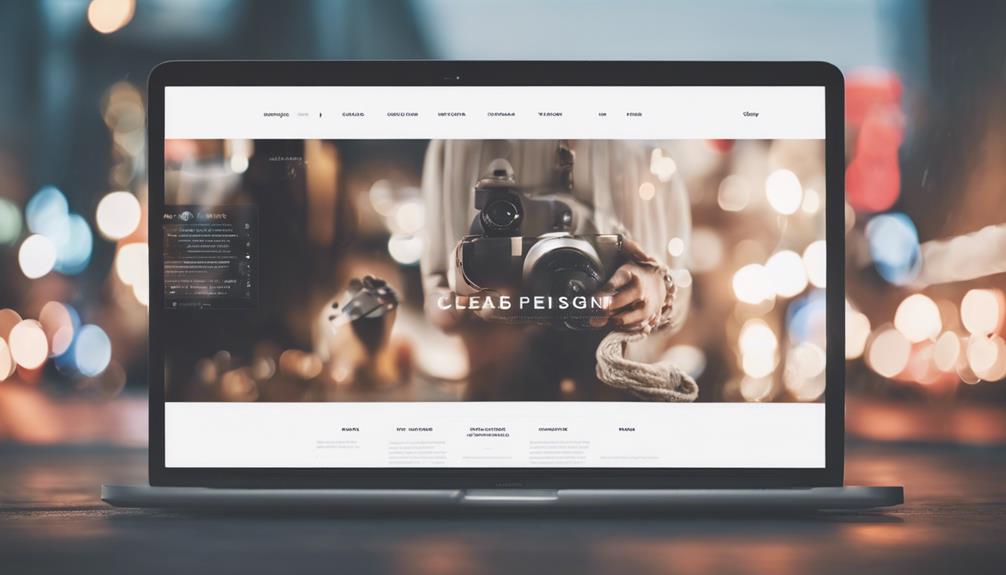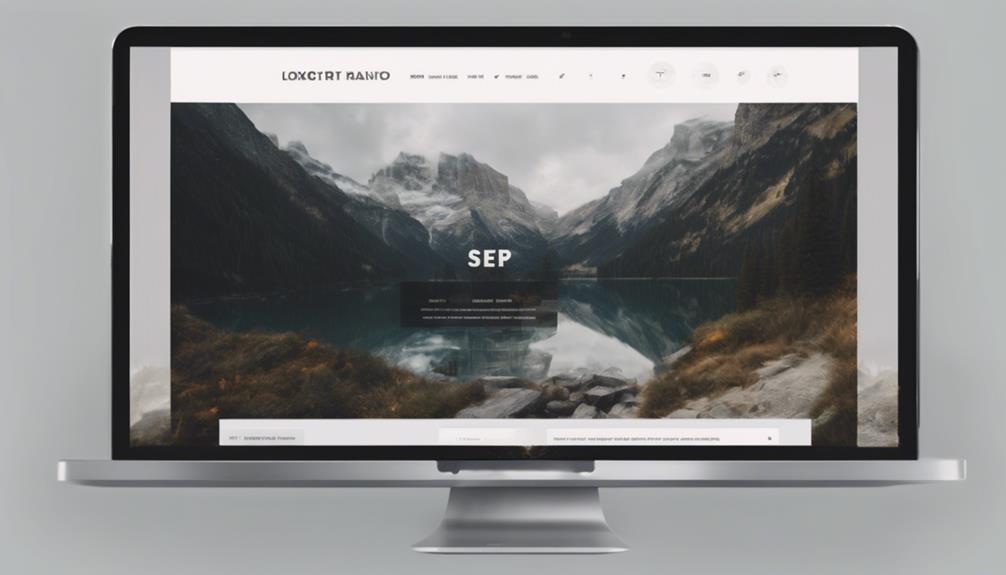Understanding the foundational principles of web design is crucial for every designer aiming to create impactful and user-friendly websites. From typography to color theory, each element plays a vital role in crafting a visually appealing and functional website.
However, mastering these principles is just the beginning. Implementing them effectively can elevate the design to new heights and ensure a seamless user experience. As we explore these essential web design principles, we unravel the key to creating compelling digital experiences that resonate with audiences on a deeper level.
Typography

Typography plays a crucial role in web design, influencing the readability and visual appeal of a website. When considering essential web design principles, the choice of fonts, sizes, spacing, and arrangements significantly impacts the overall user experience. Selecting the right typography can enhance the content’s legibility, evoke specific emotions, and establish a brand’s identity.
In essential web design, typography should be chosen with the target audience in mind. For instance, a website catering to children may require playful and colorful fonts, while a financial institution might opt for more formal and professional typography. Consistency in typography across a website helps create a cohesive look and feel, improving the overall aesthetics and usability.
Moreover, proper typography enhances the hierarchy of information, guiding visitors through the content and emphasizing key messages. By understanding the nuances of typography and applying it effectively, designers can elevate the user experience and make a website more engaging and impactful.
Color Theory
Color theory is a fundamental aspect of web design, influencing the visual impact and emotional response of a website. Understanding color theory is crucial for creating visually appealing and effective designs. In web design, colors are used to evoke specific emotions, create visual hierarchy, establish brand identity, and improve user experience.
When applying color theory to web design, designers must consider factors such as color harmony, contrast, saturation, and the psychology of colors. Color harmony ensures that the colors chosen work well together and create a pleasing visual experience for users. Contrast helps elements stand out and improves readability. Saturation levels can affect the overall mood of a website, with bright colors conveying energy and excitement, while muted tones create a more calming atmosphere.
It’s essential to choose colors that align with the brand’s identity and message. Consistency in color usage across a website helps establish a cohesive and memorable design. By mastering color theory, designers can create websites that not only look visually appealing but also effectively communicate the intended message to users.
Layout

Understanding how to structure the arrangement of elements on a webpage is essential in creating a user-friendly and visually appealing design; this is where the concept of layout plays a crucial role. In web design principles, the layout refers to how the information is organized and presented on the page. A well-thought-out layout enhances the user experience by guiding visitors through the content in a logical and intuitive manner.
When considering layout in web design ideas, designers need to focus on balance, hierarchy, and alignment. Balance ensures that elements are evenly distributed throughout the page, creating a sense of stability. Hierarchy helps prioritize content based on importance, making it easier for users to navigate. Alignment ensures that elements are placed consistently, providing a clean and organized look.
Furthermore, the layout should be responsive, adapting to different screen sizes and devices. By incorporating whitespace strategically, designers can improve readability and emphasize key elements. Overall, mastering the principles of layout is crucial for creating websites that are both functional and visually appealing.
Responsive Design
In the realm of web design, Responsive Design stands as a fundamental approach to creating websites that dynamically adjust their layout and content based on the user’s device and screen size. Responsive web design has become a standard practice due to the increasing variety of devices people use to access the internet. This approach ensures that users have a consistent experience, whether they are browsing on a desktop, tablet, or smartphone.
UI web design plays a crucial role in responsive design by focusing on creating interfaces that are user-friendly and visually appealing across different screen sizes. Incorporating responsive elements into UI design helps maintain a seamless user experience regardless of the device being used.
Keeping up with web design trends is essential for ensuring that websites remain relevant and engaging. Responsive design is not just a trend but a necessity in today’s digital landscape. Adapting to responsive web design principles ensures that websites are accessible to a wide audience and provide a positive user experience.
User Experience (UX)

Enhancing user engagement through intuitive interface design is a cornerstone of creating a seamless User Experience (UX) in web design. A web design agency or web design and SEO company focuses on optimizing the user experience to ensure visitors can navigate the site effortlessly, find information efficiently, and ultimately convert into customers.
User experience (UX) encompasses various elements such as site speed, mobile responsiveness, clear navigation, and engaging content. A well-thought-out UX design considers the target audience, their needs, and behaviors to tailor the website accordingly. By implementing user-friendly features like intuitive menus, prominent calls-to-action, and interactive elements, web designers can enhance the overall user experience.
Furthermore, conducting usability tests and gathering feedback from real users can provide valuable insights into how to improve the website’s UX. Continuously refining and optimizing the user experience is essential for a web design agency or web design and SEO company to ensure that visitors have a positive and seamless interaction with the website, leading to higher engagement and conversions.
Accessibility
To ensure that all users, regardless of any disabilities or limitations, can access and use a website effectively, web designers must prioritize accessibility in their design strategies. Accessibility in web design principles refers to creating websites that can be easily navigated and understood by all users, including those with visual, auditory, motor, or cognitive disabilities. It involves implementing features like alternative text for images, keyboard navigation, color-contrast adjustments, and clear headings to enhance user experience for individuals with disabilities.
Web design agencies play a crucial role in promoting accessibility by incorporating accessible design practices into their projects. By adhering to web accessibility standards such as the Web Content Accessibility Guidelines (WCAG), designers can ensure that websites are inclusive and functional for all users. Prioritizing accessibility not only benefits users with disabilities but also improves overall usability and search engine optimization for websites. Ultimately, integrating accessibility into web design principles is essential for creating a more inclusive online environment.
Frequently Asked Questions
How Can Designers Effectively Incorporate Animations and Transitions Into Their Web Designs?
To effectively incorporate animations and transitions into web designs, designers must carefully consider their purpose, ensuring they enhance user experience without being distracting. Use subtle animations to guide users’ attention and create a seamless browsing experience.
What Are Some Common Mistakes to Avoid When Designing a Website’s Navigation Menu?
When designing a website’s navigation menu, common mistakes to avoid include cluttered layouts, unclear labeling, inconsistent styles, lack of responsiveness, and excessive dropdown menus. Prioritize user experience, simplicity, and intuitive navigation for enhanced usability.
Can You Provide Tips for Designing a Visually Appealing and Functional Footer for a Website?
When designing a visually appealing and functional footer for a website, consider maintaining simplicity, organizing content logically, utilizing appropriate spacing, incorporating relevant links, and ensuring responsiveness across devices to enhance user experience and overall website navigation.
How Can Designers Balance Creativity With Usability When Designing a Website?
When balancing creativity with usability in web design, designers should prioritize user experience. Implement intuitive navigation, clear calls to action, and consistent design elements. Test designs with real users to ensure both creativity and usability enhance the overall functionality and appeal of the website.
What Are Some Best Practices for Optimizing Web Design for Search Engine Optimization (Seo)?
Optimizing web design for SEO involves strategic use of keywords, meta tags, and quality content. Implementing responsive design, optimizing images, improving site speed, and building backlinks are crucial. Regularly monitoring analytics and staying updated on SEO trends are essential for success.








